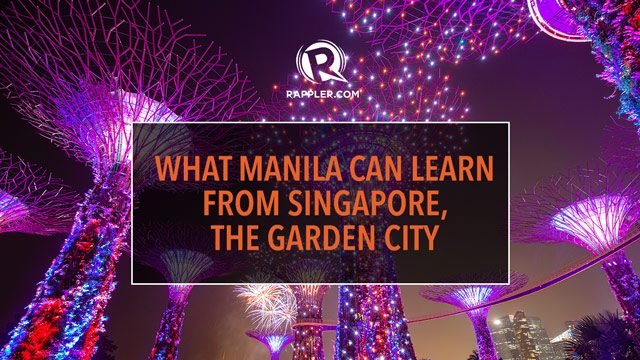SUMMARY
This is AI generated summarization, which may have errors. For context, always refer to the full article.

SINGAPORE – The Philippines and Singapore – geographically close, but decades apart in progress.
What can Manila learn from its next-door neighbor?
Ayee Macaraig reports.
This is not Disneyland, but Singapore’s brand of eco-tourism.
More sits Gardens by the Bay – show supertrees, Skypark, domes
Gardens by the Bay are the latest attraction in the city in a garden that is Singapore.
A global model in urban planning and design, the Lion City celebrates its 50th anniversary including its makeover from being a swampland to Asia’s most livable city.
Singapore is not just home to the world’s best airport and one of the busiest ports, but also to 300 parks and 4 nature reserves.
How did this small Southeast Asian nation turn its slums into an urban oasis?
Filipino urban designer Paulo Alcazaren says the metropolis built on its master plan…
and constantly reviews it.
The landscape architect helped improve on the design of tourist sites like Orchard Road, Chinatown and Little India in the 1980s and 1990s.
PAULO ALCAZAREN, URBAN DESIGNER & LANDSCAPE ARCHITECT: The original master plan from the 1960s is reviewed every 5 years, and there’s a major re-look every 10 years. A master plan is never set in stone. It’s just a framework but you need to have a point where to start, which is the total opposite in Manila. We had plans but they never used them, really, as any point for development.
Singapore also has a network of parks and open spaces integrated into residential and business areas making for a walkable and bike-friendly city.
This is the Singapore Botanic Gardens, recently named a UNESCO World Heritage Site, the first botanic gardens in Asia to make it on the list.
It successfully implemented Lee Kuan Yew’s vision of Singapore as a Garden City and is crucial to its cultural and social heritage.
Effective governance and smart policies make Singapore’s blueprint a reality.
Faced with a scarcity of natural resources, Singapore makes the most use out of its limited land area.
It went vertical in building structures like public housing.
From 580 square kilometers, the island-nation is now 718 square kilometers in size due to reclamation.
It conserves heritage by turning colonial buildings into hotels and galleries.
While it lacked water just decades back, Singapore now has 17 reservoirs, and an outstanding system of water collection, treatment and recycling.
DR VIVIAN BALAKRISHNAN, MINISTER FOR THE ENVIRONMENT AND WATER RESOURCES: The point is although we didn’t invent resource osmosis, but because we have an existential need and we have a single-minded, coordinated focus, we can take an idea, prototype it, make it work, upscale it into a national solution and today we have a water industry, water companies, that can now access global opportunities elsewhere.
Alcazaren says while the Philippines is incomparable to Singapore, leaders of urban centers like Metro Manila, Cebu and Davao must take the cue from the city-state.
PAULO ALCAZAREN, URBAN DESIGNER & LANDSCAPE ARCHITECT: Our National Building Code, and our local ordinances only look at very localized situations that does not set any connections to the larger context. And then it’s a problem of jurisdiction of infrastructure responsibilities. You have the DPWH, the local governments because of the decentralization.
The architect suggests creating metropolitan units to centralize governance instead of having 17 town and city mayors making different rules and plans.
On Singapore’s 50th birthday it takes pride in its glittering skyscrapers and world-renowned parks.
But the more remarkable achievement is the governance and management that built these structures, elements that are not exclusive to this first-world nation, and something its neighbors ideally copy and adapt.
Ayee Macaraig, Rappler, Singapore. – Rappler.com
Add a comment
How does this make you feel?
There are no comments yet. Add your comment to start the conversation.